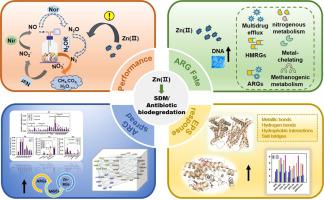当前位置:
X-MOL 学术
›
Water Res.
›
论文详情
Our official English website, www.x-mol.net, welcomes your feedback! (Note: you will need to create a separate account there.)
Fate of antibiotic resistance genes and EPS defence mechanisms during simultaneous denitrification and methanogenesis, coupled with the biodegradation of multiple antibiotics under zinc stress
Water Research ( IF 11.4 ) Pub Date : 2024-06-24 , DOI: 10.1016/j.watres.2024.121996 Jierong Zheng , Sufang Wang , Qing Gong , Aijuan Zhou , Bin Liang , Bowei Zhao , Houfen Li , Xiao Zhang , Yu Yang , Xiuping Yue
Water Research ( IF 11.4 ) Pub Date : 2024-06-24 , DOI: 10.1016/j.watres.2024.121996 Jierong Zheng , Sufang Wang , Qing Gong , Aijuan Zhou , Bin Liang , Bowei Zhao , Houfen Li , Xiao Zhang , Yu Yang , Xiuping Yue

|
High-strength nitrogen and antibiotics-containing wastewater can be efficiently eliminated by simultaneous denitrification and methanogenesis (SDM). Heavy metals and antibiotics are two critical factors that can lead to horizontal transfer of antibiotic resistance genes (ARGs), which can be simultaneously detected in wastewater. Unfortunately, the impacts of heavy metals on SDM and antibiotic biodegradation have not been fully elucidated. Herein, the effects of SDM and multiple antibiotics biodegradation, extracellular polymeric substances (EPSs) and protein response mechanisms, and ARG fate under Zn(II) stress were comprehensively evaluated. The results indicated that a high level of Zn(II) (≥5 mg/L) stress significantly decreased the degradation rate of multiple antibiotics and suppressed denitrification and methanogenesis. In addition, Zn(II) exposure prompted the liberation of proteins from microbes into the EPSs, and the combination of EPSs with small molecules quenched the original fluorescent components and destroyed the protein structure. The dominant proteins can bind to both Zn(II) and multiple antibiotics through several types of chemical interactions, including metallic and hydrogen bonds, hydrophobic interactions, and salt bridges, relieving the toxicity of harmful substances. Moreover, metagenomic sequencing revealed that the abundance of zinc resistance genes (Zn-RGs), ARGs (mainly tetracyclines), and mobile genetic elements (MGEs) increased under Zn(II) stress. Mantel test illustrated that the ARGs mecD, tetT, and tetB(60) were most affected by MGEs. Moreover, molecular network analysis revealed that several MGEs can bridge metal resistance genes (MRGs) and ARGs, facilitating the horizontal transfer of ARGs. This study provides theoretical guidance for the environmental risk control of antibiotics-containing wastewater treated by an SDM system.
中文翻译:

同时反硝化和产甲烷过程中抗生素抗性基因和 EPS 防御机制的命运,以及锌胁迫下多种抗生素的生物降解
通过同时反硝化和产甲烷(SDM)可以有效消除高浓度氮和含抗生素废水。重金属和抗生素是导致抗生素抗性基因(ARG)水平转移的两个关键因素,可以在废水中同时检测到。不幸的是,重金属对 SDM 和抗生素生物降解的影响尚未完全阐明。在此,综合评估了SDM和多种抗生素生物降解的影响、细胞外聚合物(EPS)和蛋白质反应机制以及Zn(II)胁迫下ARG的命运。结果表明,高水平的 Zn(II) (≥5 mg/L) 胁迫显着降低了多种抗生素的降解速率,并抑制了反硝化和产甲烷作用。此外,Zn(II)暴露促使微生物中的蛋白质释放到EPS中,EPS与小分子的结合淬灭了原有的荧光成分并破坏了蛋白质结构。主要蛋白质可以通过多种化学相互作用(包括金属键和氢键、疏水相互作用和盐桥)与 Zn(II) 和多种抗生素结合,从而减轻有害物质的毒性。此外,宏基因组测序显示,锌抗性基因(Zn-RGs)、ARGs(主要是四环素)和移动遗传元件(MGEs)的丰度在Zn(II)胁迫下增加。 Mantel测试表明ARGs mecD、tetT和tetB(60)受MGEs影响最大。此外,分子网络分析表明,一些MGE可以桥接金属抗性基因(MRG)和ARG,促进ARG的水平转移。 该研究为SDM系统处理含抗生素废水的环境风险控制提供理论指导。
更新日期:2024-06-24
中文翻译:

同时反硝化和产甲烷过程中抗生素抗性基因和 EPS 防御机制的命运,以及锌胁迫下多种抗生素的生物降解
通过同时反硝化和产甲烷(SDM)可以有效消除高浓度氮和含抗生素废水。重金属和抗生素是导致抗生素抗性基因(ARG)水平转移的两个关键因素,可以在废水中同时检测到。不幸的是,重金属对 SDM 和抗生素生物降解的影响尚未完全阐明。在此,综合评估了SDM和多种抗生素生物降解的影响、细胞外聚合物(EPS)和蛋白质反应机制以及Zn(II)胁迫下ARG的命运。结果表明,高水平的 Zn(II) (≥5 mg/L) 胁迫显着降低了多种抗生素的降解速率,并抑制了反硝化和产甲烷作用。此外,Zn(II)暴露促使微生物中的蛋白质释放到EPS中,EPS与小分子的结合淬灭了原有的荧光成分并破坏了蛋白质结构。主要蛋白质可以通过多种化学相互作用(包括金属键和氢键、疏水相互作用和盐桥)与 Zn(II) 和多种抗生素结合,从而减轻有害物质的毒性。此外,宏基因组测序显示,锌抗性基因(Zn-RGs)、ARGs(主要是四环素)和移动遗传元件(MGEs)的丰度在Zn(II)胁迫下增加。 Mantel测试表明ARGs mecD、tetT和tetB(60)受MGEs影响最大。此外,分子网络分析表明,一些MGE可以桥接金属抗性基因(MRG)和ARG,促进ARG的水平转移。 该研究为SDM系统处理含抗生素废水的环境风险控制提供理论指导。











































 京公网安备 11010802027423号
京公网安备 11010802027423号